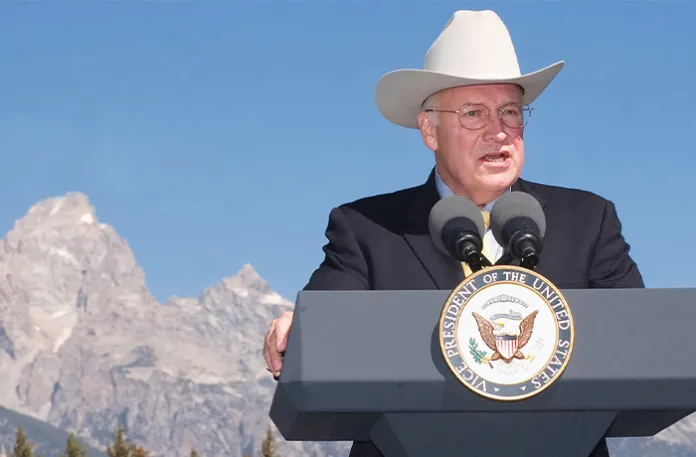Like many Americans of my generation, I didn’t think much about vice presidents growing up. Al Gore, the first one most millennials such as me remember, was mostly a punchline — mocked on The Simpsons for measuring the Oval Office drapes and lampooned elsewhere for supposedly claiming he invented the internet. Vice presidents seemed like footnotes, placeholders in the shadow of the commander in chief. But like so much else that Sept. 11, 2001, shattered, that perception crumbled too. I remember huddling by the radio that day, listening as the world was unraveling in real time, when reports filtered through about Dick Cheney being hustled into an underground White House bunker, secured and sequestered in a way that made him seem more vital and more endangered than even President George W. Bush himself.
In the fog of fear and fury, Cheney emerged not as a sidekick but as a linchpin — a steady hand guiding the nation’s first strokes of retaliation against an unseen enemy. That image stuck with me: Cheney as the unassuming Wyomingite with a gravelly voice and wire-rimmed glasses who had suddenly become the most indispensable man in Washington.
Richard Bruce Cheney was born Jan. 30, 1941, in Lincoln, Nebraska, to a federal soil conservationist and a homemaker. The family moved to Casper, Wyoming, at age 13, where the high plains’ relentless wind and vast skies forged a worldview of self-reliance and quiet resolve. A lanky teenager prone to mischief — drinking, fighting, skipping school — Cheney flunked out of Yale after two years. He later recounted that during his time in New Haven, he had fallen in with “some kindred souls, young men like me who were not adjusting very well [to Yale] and shared my opinion that beer was one of the essentials of life.” He deferred college to work as a lineman, stringing power lines through Wyoming’s brutal winters, an experience he cited as proof of American grit. At 21, he enrolled at the University of Wyoming, earning a bachelor’s in 1965 and a master’s in political science in 1966. His wife, Lynne, wrote historical novels and later chaired the National Endowment for the Humanities under Presidents Ronald Reagan and Bush, and defended traditional values with unflinching clarity. They raised two daughters: Elizabeth, who became Liz Cheney, a Wyoming congresswoman and vocal Trump critic, and Mary, whose public coming out as gay in the 1990s forced her father to navigate private loyalty against conservative orthodoxy. The tension never fractured the family. It humanized the man who, otherwise, projected granite resolve.

By 1969, Cheney was in Washington as an intern for Rep. William Steiger (R-WI). He climbed through the Nixon and Ford administrations, handling energy policy at the Cost of Living Council and serving as deputy to White House counsel Donald Rumsfeld, his lifelong friend and ideological twin. At 34, he became Gerald Ford’s chief of staff (1975-1977), helping stabilize the post-Watergate chaos. Ford called him “whip-smart.” His ascent reflected a rare blend of Midwestern pragmatism and Washington savvy, a man who preferred backrooms to podiums and memos to microphones.
He won Wyoming’s House seat in 1978 after Steiger’s sudden death from a heart attack, chaired the Republican Policy Committee, and became minority whip in 1989. He served as George H.W. Bush’s defense secretary from 1989 to 1993, overseeing Cold War drawdowns while leading Operation Desert Storm’s 100-hour ground war that expelled Saddam from Kuwait. “We were not trying to conquer Iraq,” he told reporters at the Pentagon. “We were trying to liberate Kuwait. And we accomplished that.”
After Bush’s loss to Clinton in 1992, Cheney became the CEO of Halliburton, but he didn’t remain in the private sector for long. George W. Bush, looking for an experienced Washington hand, tapped him as running mate. Inaugurated on Jan. 20, 2001, Cheney chaired the energy task force and shaped foreign policy. On 9/11, from the White House bunker, he ordered airspace cleared and authorized the shooting down of the hijacked planes. He championed preemption and the unitary executive theory, linking Iraq to al Qaeda and WMDs — claims later debunked but which were pivotal to justifying the 2003 invasion. He defended enhanced interrogation, the Patriot Act, and Guantanamo.
His heart attacks began at 37 in 1978. Five more followed. By 2010, he needed a pump. A heart transplant, which he was fortunate to receive in 2012, ended up extending his life by over a dozen years. The somewhat fortuitous transplant was the metatext of Adam McKay’s 2018 film Vice, which starred a completely transformed (and later Oscar-nominated) Christian Bale as Cheney, Amy Adams as Lynne, and Steve Carell as Donald Rumsfeld.
Cheney, who died on Nov. 4 at the age of 84, leaves a contested legacy. Critics, such as McKay and his film, blame him for the Iraq quagmire — nearly 5,000 U.S. deaths and trillions of dollars spent for apparently little in return — and for the erosion of civil liberties. Admirers credit him with preventing further attacks and elevating the vice presidency from ceremonial to consequential. In an age of bluster, his quiet command reshaped American power. He was the man who was one heartbeat from the presidency, yet who was often its driving force.
Daniel Ross Goodman is a Washington Examiner contributing writer and the Allen and Joan Bildner Visiting Scholar at Rutgers University. Find him on X @DanRossGoodman.

